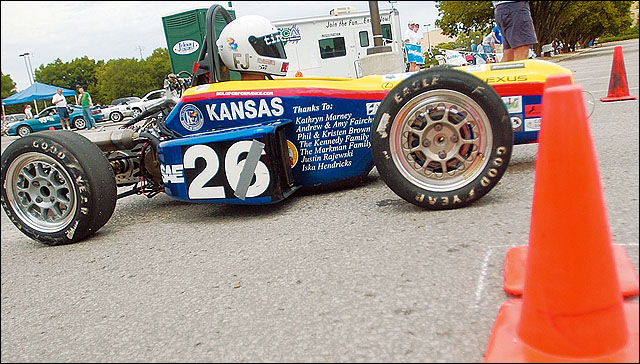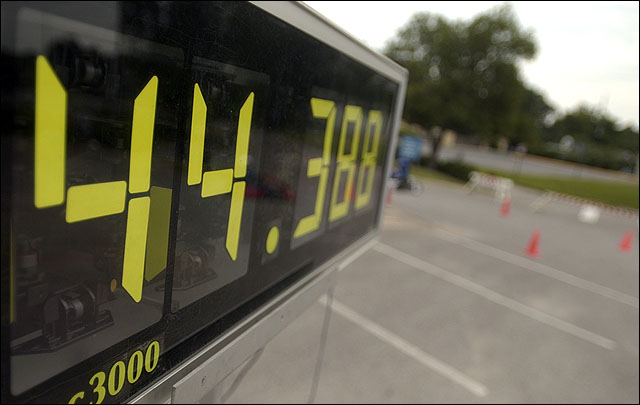Jayhawk Motorsports team embraces successful finish

Garrett Witthar, Kansas University senior, waits for his signal at the starting line in the Robinson Gymnasium parking lot. The Jayhawk Motorsports team drove the car during a July 3 race. The team built the car itself.
In addition to learning skills that will help him in his future career, Kansas University engineering junior Erich Ohlde has another reason he is involved with the Jayhawk Motorsports team.
“There’s definitely the cool factor,” he said.
Ohlde is one of about 30 students at KU who work to build a formula-style racing car from scratch every year. The team has nine months – an academic year – to finish the task. About half of the team are seniors who work on the car as their senior design project. The other half is made up of volunteers like Ohlde.
The goal is to have the car in shape to test well in May at the Society of Automotive Engineers Formula Car Challenge in Pontiac, Mich. This year, KU’s car finished 12th out of 140 teams. That’s the highest-ever finish for the team, which started competing in 1994.
Skills for the ‘real world’
In addition to the “cool factor,” students get a lot out of participating, said Robert Sorem, associate dean of engineering and faculty adviser for the team.
“It’s a large engineering project,” Sorem said. “Students can step in and get a very real dose of what goes on in a real engineering project.”
In addition to applying theories they have learned in class, the students must use teamwork skills to finish the car. Learning to work well with others – something that doesn’t always come natural to engineers – is essential to build a good car, Sorem said.

The Jayhawk Motorsports Team, which comprises KU School of Engineering students and volunteers, hopes to improve its 12th-place finish in the Society of Automotive Engineers Formula Car Challenge. That ranking, from May 2004, is the team's best-ever finish.
Also, the competition can help students in the job hunt. Recruiters from a variety of companies are often at the competition.
“A large number of the companies out there recognize what the competition is, what students have to do and sacrifices to participate in it,” Sorem said. “That’s even if the student doesn’t want to go into the automotive industry. Non-auto companies know what the competition is.”
Some students will spend between 100 and 120 hours a week working on the car, while others will spend between 30 and 40 hours, Sorem said.
Scott Chapman, a graduate student who served as team captain in 2003, said building a car from scratch was both a “total nightmare” and a “great experience because you learn the ins and outs of how things are manufactured. Seeing it from that end, I think, makes you a better designer.”
In addition to design, the senior leaders of the project are in charge of fundraising, managing volunteers and developing a marketing plan for the car.
“All skills that will really help out there in the real world,” Chapman said.
Future looks bright
This year’s car featured a Honda F4i engine, a carbon monocoque frame, a carbon fiber body and a pneumatic shifter. It takes six seconds to go from zero to 90 miles per hour.
Members of the team, including Ohlde and junior Nick Roberts, spent the summer testing the car and racing it at various events.
Roberts said he thought the team had a chance to finish in the top 10 of the competition next year.
“It’s been doing really well at these races,” Roberts said. “Next year, we’ll be basing the car a lot off of this year’s car. Finishing in the top five is not out of the question.”
For Sorem – who said he’s learned something new in each one of his 10 years as the team’s adviser – the best part is seeing the students accomplish a hard, tedious task.
“They have a lot of fun with it,” he said. “It’s a lot of work, and they’re glad when it’s over. But the first time you design anything – and you build it from scratch and you see that it works and what it can do – it’s a high. It’s exhilarating.”







